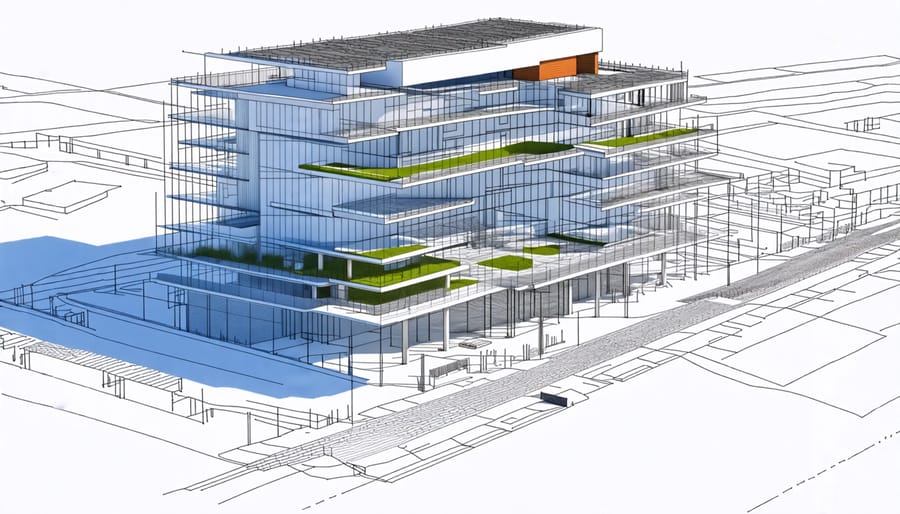Leverage 3D BIM modeling to streamline construction processes by integrating design, engineering, and manufacturing data into a unified digital platform. Enhance collaboration and communication across project teams, from architects to project managers, ensuring that everyone accesses the most up-to-date and accurate information. Implement regular 3D model updates to maintain accuracy and foresee potential clashes, improving project efficiency and reducing errors. Employ this approach to facilitate the “digital transformation” in your construction projects, embracing innovative technologies that drive the industry forward. Ensure your team is equipped with the necessary training and tools to maximize the benefits offered by 3D BIM modeling, thereby improving project outcomes and client satisfaction.
Key Benefits of 3D BIM in Construction

Enhanced Collaboration
3D BIM modeling significantly enhances collaboration among construction stakeholders by facilitating clear and effective communication. Through its highly detailed digital representations, BIM enables architects, engineers, and project managers to share and visualize intricate design concepts effortlessly. This transparency reduces misunderstandings and errors, ensuring all parties are aligned throughout the project lifecycle. Enhanced model-based coordination allows for real-time updates and feedback, streamlining decision-making processes and fostering a collaborative environment. By integrating various disciplines into a single cohesive model, 3D BIM contributes to more efficient project management, reducing delays and fostering a proactive approach to solving complex construction challenges.
Improved Project Visualization
3D BIM modeling significantly enhances project visualization, offering construction professionals a dynamic and comprehensive view of architectural designs. This advanced visualization capability allows stakeholders to immerse themselves in the project, understanding spatial relationships and design details with greater clarity than traditional 2D drawings. By simulating real-world conditions and environments, it aids architects and engineers in identifying potential design flaws early in the process, facilitating informed decision-making. Moreover, the interactive nature of 3D models assists project managers in explaining complex concepts to clients and teams, ensuring all parties have a unified understanding of project goals and expectations, thereby reducing misconceptions and miscommunications.
Cost and Time Efficiency
3D BIM modeling significantly enhances project efficiency by streamlining design processes and facilitating collaboration among stakeholders. This integrated approach reduces errors and rework, leading to a notable decrease in costs. With centralized data and visualization tools, teams can swiftly identify potential issues, allowing for prompt resolution and minimizing delays. Real-world case studies reveal projects completed up to 30% faster when employing BIM, demonstrating the model’s ability to optimize timelines. Costs are further reduced through better material estimation and clash detection, enhancing resource allocation and overall budget management.
Case Studies: 3D BIM in Action

Interview with Industry Experts
Leading architects and project managers are strongly advocating for the integration of 3D BIM modeling in the construction industry, highlighting its profound impact on project success. Jane Thompson, a seasoned architect with over 20 years of experience, states, “BIM has revolutionized how we approach design, providing an unprecedented level of precision and coordination.” John Davis, a project manager renowned for his expertise in large-scale developments, adds, “The collaborative nature of 3D BIM allows for real-time problem-solving and reduces costly rework.” Both experts agree that the transition to BIM requires careful planning and training, yet the advantages are significant. For instance, enhanced visualization during the design phase fosters better decision-making, ultimately leading to higher-quality outcomes. Furthermore, they emphasize the necessity of ongoing education to maximize the technology’s potential. As the construction industry continues to evolve, embracing innovative tools like 3D BIM modeling is critical for maintaining competitiveness and delivering successful projects on time and within budget.
Notable Projects Leveraging 3D BIM
In the realm of construction, 3D BIM (Building Information Modeling) has revolutionized the way projects are designed, executed, and managed. Notable projects across the globe showcase its transformative capabilities, setting new standards in efficiency and collaboration. For instance, the Crossrail project in London is a testament to 3D BIM’s potential, where it facilitated collaborative efforts among stakeholders, leading to optimized workflows and significant cost savings. The project leveraged detailed 3D models to integrate complex data from various engineering disciplines, allowing teams to identify and mitigate potential clashes before construction commenced.
Another example is the Sydney Opera House’s refurbishment, which saw 3D BIM technology breathe new life into the iconic structure. By creating an accurate digital model of the existing building, engineers and architects managed to preserve its historical essence while implementing modern upgrades. This project demonstrated BIM’s power in asset management, providing an ongoing digital twin to inform future renovations and maintenance.
Similarly, the construction of the Levi’s Stadium in California employed 3D BIM to enhance project delivery. The technology enabled precise scheduling and materials management, reducing waste and ensuring timely completion. By fostering real-time communication between architects, engineers, and contractors, 3D BIM ensured that the stadium was designed and constructed to the highest standards, setting a benchmark for future smart stadium projects. These projects highlight how 3D BIM is not just a tool for design but a critical component for successful project execution, offering insights that extend beyond construction into lifecycle management.
Challenges in Adopting 3D BIM
Technical Hurdles
In the realm of 3D BIM modeling, construction professionals encounter a range of technical hurdles primarily associated with software complexities and infrastructure demands. Among these challenges, compatibility issues across different software platforms often lead to inefficiencies and data inconsistencies, which can impede the seamless collaboration needed for intricate projects. Additionally, the steep learning curve associated with mastering sophisticated 3D BIM tools necessitates substantial time and resource investment in training and skill development. Infrastructure-wise, ensuring that all stakeholders have access to high-performance computing resources and robust network systems is critical for handling the massive data files intrinsic to detailed BIM models. These technical requirements can be a barrier for some firms, particularly smaller ones, which may struggle with the necessary investment in hardware and software upgrades, thereby limiting their ability to fully leverage the benefits of 3D BIM technology.
Cultural and Organizational Barriers
The implementation of 3D BIM modeling in construction faces significant cultural and organizational barriers. Many organizations exhibit reluctance due to a deeply ingrained preference for traditional methods. This resistance is often fueled by a lack of understanding of the technology’s potential, compounded by the perceived complexity of transitioning from familiar practices. Furthermore, the adaptation challenge is exacerbated by insufficient training and support for staff, which hinders the development of necessary skills to fully leverage BIM’s capabilities. Organizational inertia also plays a role, as companies may hesitate to revise established processes and invest in new tools without a clear demonstration of tangible benefits. Addressing these barriers requires leadership commitment to cultivating a culture of innovation and ensuring that all stakeholders recognize the strategic advantages of embracing 3D BIM modeling for enhanced project outcomes.
Future Trends and Innovations in 3D BIM
Integration with AI and Machine Learning
The integration of AI and machine learning with 3D BIM modeling is revolutionizing the construction industry by unlocking unprecedented capabilities. As AI progresses, it enhances BIM models with predictive analytics, allowing for more accurate forecasting of project outcomes. This technology aids in identifying potential design flaws before they manifest on-site, thus reducing costly rework. Additionally, machine learning algorithms are being utilized to automate mundane tasks such as clash detection, freeing up valuable time for architects and engineers to focus on more creative and strategic aspects of design. Through in-depth case studies, construction professionals have reported a significant reduction in project timelines and improved resource allocation by leveraging AI-driven insights. Industry experts are optimistic about AI’s potential to refine the decision-making process, ensuring projects are not only completed more efficiently but also sustainably, which aligns with the long-term goals of many construction firms. Embracing these advancements, 3D BIM modeling continues to evolve, offering a more intelligent approach to construction management.

Sustainability and Energy Efficiency
3D BIM modeling is revolutionizing the way the construction industry approaches sustainability and energy efficiency. By allowing construction professionals to visualize the entire lifecycle of a building, BIM facilitates informed decision-making that prioritizes sustainable construction practices. For instance, architects and engineers can utilize BIM to evaluate multiple design and material options, ensuring optimal energy usage and minimal environmental impact. This adaptability is crucial for aligning projects with eco-friendly goals and regulatory standards.
Furthermore, the integration of BIM with energy analysis tools enhances a project’s energy performance. Detailed simulations can predict energy consumption, identifying potential inefficiencies early in the design phase. This proactive approach has been demonstrated in numerous in-depth case studies, where BIM’s role in reducing energy costs and enhancing building performance is clear.
Additionally, expert insights highlight BIM’s capability to streamline the incorporation of renewable energy sources, leading to more efficient building designs. By embracing these innovative tools, the construction industry is steadily advancing towards a future where sustainable construction becomes the norm, meeting both client expectations and environmental standards with precision and care.
Conclusion
3D BIM modeling stands at the forefront of technological advancements in the construction industry, marking a transformative shift from traditional practices. Its ability to create detailed, multi-dimensional virtual representations of buildings offers numerous benefits, including enhanced collaboration among architects, engineers, and construction managers. By integrating data-rich models, project teams can foresee potential conflicts, reduce waste, and optimize resource management. The insights shared through expert interviews and case studies highlight how early adopters have already seen improvements in efficiency and cost-effectiveness, setting a new standard for project execution. Furthermore, as more firms embrace BIM, even wider implementation can be expected, catalyzing innovations in design, planning, and sustainability. While challenges such as high initial costs and the need for specialized training pose hurdles, the long-term gains in efficiency and reduced project risks make a compelling case for investment. Looking forward, the evolution of BIM with emerging technologies like AI and IoT promises to further revolutionize construction practices. Embedding predictive analytics within BIM models can offer unprecedented foresight into project timelines and risk management. As the industry navigates these advancements, staying informed and agile will be key for construction professionals seeking to leverage full potential of BIM in driving future growth.

